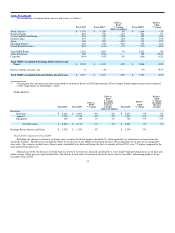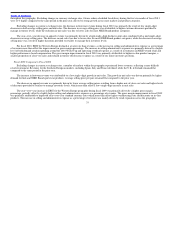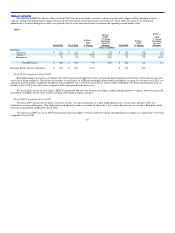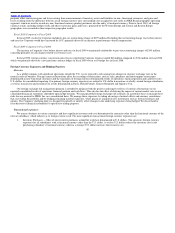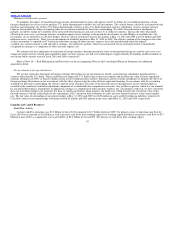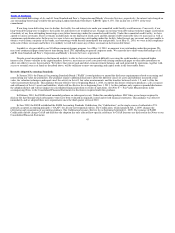Nike 2010 Annual Report Download - page 42
Download and view the complete annual report
Please find page 42 of the 2010 Nike annual report below. You can navigate through the pages in the report by either clicking on the pages listed below, or by using the keyword search tool below to find specific information within the annual report.
Table of Contents
Fiscal 2010 Compared to Fiscal 2009
Our Other Businesses are comprised of Cole Haan, Converse, Hurley, NIKE Golf and Umbro. For fiscal 2010, the increase in Other Businesses’
revenue was primarily driven by revenue growth at Converse, Umbro and Hurley, which more than offset the declines at NIKE Golf and Cole Haan due to
reductions in consumer discretionary spending in their respective markets.
In fiscal 2009, EBIT for our Other Businesses included a $401 million pre−tax non−cash charge relating to the impairment of goodwill, intangible and
other assets of Umbro. Excluding this impairment charge, EBIT for our Other Businesses would have increased 43%, as a result of higher revenues,
improved gross margins across most businesses, and lower demand creation spending.
Fiscal 2009 Compared to Fiscal 2008
For fiscal 2009, our Other Businesses were comprised of Cole Haan, Converse, Hurley, NIKE Golf and Umbro. For fiscal 2008, our Other
Businesses primarily included Cole Haan, Converse, Exeter (whose primary business was the Starter brand business which was sold on December 17,
2007), Hurley, NIKE Bauer Hockey (which was sold on April 17, 2008), NIKE Golf and Umbro (which was acquired on March 3, 2008).
Excluding the loss of revenue from NIKE Bauer Hockey and the Starter brand business and the addition of Umbro, Other Businesses revenues for
fiscal 2009 would have increased 6%, driven by the strong performance from Converse and Hurley, offset by sales decreases at NIKE Golf and Cole Haan,
due to reductions in consumer discretionary spending in their respective markets.
EBIT for Other Businesses declined for fiscal 2009 primarily as a result of a $401 million pre−tax non−cash impairment charge to reduce the carrying
value of Umbro’s goodwill intangible and other assets. Excluding the impairment charge, the loss of income from NIKE Bauer Hockey and the Starter
brand business along with the dilutive impact of Umbro, earnings before interest and taxes for Other Businesses would have decreased by 28%, driven by
declines in operating results at NIKE Golf and Cole Haan.
For additional information about our impairment charges, see Note 4 — Acquisition, Identifiable Intangible Assets, Goodwill and Umbro Impairment
in the Notes to the Consolidated Financial Statements.
Corporate
Fiscal 2010 Fiscal 2009
FY10 vs.
FY09
% Change Fiscal 2008
FY09 vs.
FY08
% Change
(dollars in millions)
Revenues $ (24) $ — — $ — —
Loss Before Interest and Taxes $ (894) $ (955) −6% $ (854) 12%
Fiscal 2010 Corporate revenues primarily consist of foreign currency revenue−related hedge gains and losses generated by entities within the NIKE
Brand geographic operating segments through our centrally managed foreign exchange risk management program and foreign currency gains and losses
resulting from the difference between actual foreign currency rates and standard rates assigned to these entities, which are used to record any non−functional
currency revenues into the entity’s functional currency.
Corporate’s loss before interest and taxes consists of unallocated general and administrative expenses, which includes expenses associated with
centrally managed departments, depreciation and amortization related to the Company’s corporate headquarters, unallocated insurance and benefit
programs, certain foreign currency gains and losses, including certain hedge gains and losses, corporate eliminations and other items. In addition to the
foreign currency gains and losses recognized in Corporate revenues, foreign currency results include all other foreign currency hedge results generated
through our centrally managed foreign exchange risk management
39




